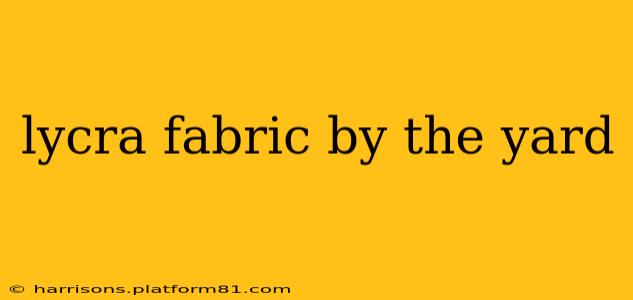Lycra fabric, also known as spandex or elastane, is a popular choice for clothing and other applications due to its exceptional stretch and recovery properties. Buying Lycra fabric by the yard offers unparalleled flexibility for projects big and small, from swimwear and athletic wear to dance costumes and even home décor accents. This comprehensive guide will delve into everything you need to know about finding, using, and caring for Lycra fabric purchased by the yard.
What is Lycra Fabric?
Lycra is a synthetic fiber known for its exceptional elasticity. It's not typically used on its own, but rather blended with other fibers like nylon, polyester, or cotton to provide stretch and comfort. The percentage of Lycra in a blend dictates its level of stretch and recovery. A higher percentage means more stretch. Understanding the fiber content is crucial for choosing the right fabric for your project.
Where to Buy Lycra Fabric by the Yard?
You have several options for sourcing Lycra fabric by the yard:
- Online Retailers: Websites specializing in fabrics offer a vast selection of colors, weights, and blends. Many provide detailed product descriptions and customer reviews, allowing for informed purchasing decisions. Be sure to check shipping costs and return policies before ordering.
- Local Fabric Stores: Visiting a local fabric store provides the advantage of physically examining the fabric, feeling its texture, and assessing its quality. The staff can also offer valuable advice and guidance on selecting the appropriate fabric for your needs.
- Specialty Stores: Some stores focus on specific types of fabric, such as swimwear or dancewear fabric, and will carry a wide range of Lycra options suitable for those purposes.
What are the Different Types of Lycra Fabric?
The type of Lycra fabric you choose will depend heavily on your intended use. Some key distinctions include:
- Weight: Lycra fabric comes in various weights, ranging from lightweight for lingerie to heavier weights suitable for sportswear. Heavier weights offer more support and structure.
- Blend: The blend of fibers affects the fabric's drape, durability, and overall feel. Common blends include Lycra with nylon (for swimwear), Lycra with cotton (for comfortable clothing), and Lycra with polyester (for performance wear).
- Finish: Lycra fabric can have various finishes, such as matte, shiny, or textured. The finish influences the fabric's look and feel.
How Much Lycra Fabric Do I Need?
Accurately calculating the yardage required is crucial to avoid fabric shortages. Consider these factors:
- Project Pattern: Follow the pattern's instructions carefully for yardage requirements.
- Fabric Width: The width of the fabric influences the amount needed.
- Nap: Some Lycra fabrics have a nap, meaning the fabric has a directional texture. Ensure you cut all fabric pieces in the same direction.
What are the Pros and Cons of Using Lycra Fabric?
Pros:
- Comfort and Stretch: Lycra provides exceptional comfort and flexibility.
- Shape Retention: It helps garments maintain their shape even after repeated wear and washing.
- Durability: Lycra blends are generally durable, especially when properly cared for.
- Versatility: It can be used in various applications.
Cons:
- Can be Expensive: Compared to some other fabrics, Lycra can be relatively expensive.
- Requires Specific Care: It needs special care to maintain its elasticity and prevent damage.
- Can Snag: Depending on the blend, Lycra can be prone to snagging.
How to Sew with Lycra Fabric?
Sewing with Lycra requires specific techniques:
- Use a Ballpoint Needle: This prevents the needle from piercing the Lycra fibers.
- Use a Stretch Stitch: Choose a stretch stitch on your sewing machine to accommodate the fabric's elasticity.
- Use a Serger (Optional): A serger provides professional-looking seams and prevents fraying.
- Test Your Stitch: Before starting your project, always test your stitch on a scrap piece of fabric.
How to Care for Lycra Fabric?
Proper care ensures the longevity of your Lycra garments:
- Hand Wash or Delicate Cycle: Always hand wash or use a gentle cycle in the washing machine.
- Cool Water: Use cool water to prevent shrinkage and damage.
- Air Dry: Air drying is best, but if machine drying is necessary, use a low setting.
- Avoid Bleach: Bleach can damage the fabric's fibers.
What Projects are Suitable for Lycra Fabric?
Lycra's versatility makes it ideal for a wide range of projects, including:
- Swimwear: Bikinis, swimsuits, and rash guards.
- Activewear: Leggings, yoga pants, and sports bras.
- Dancewear: Leotards, tights, and dance costumes.
- Underwear: Lingerie and shapewear.
- Accessories: Headbands, wristbands, and scrunchies.
This guide provides a comprehensive overview of Lycra fabric by the yard. Remember to always consult the fabric's care instructions and test your techniques before starting a larger project. Happy sewing!
